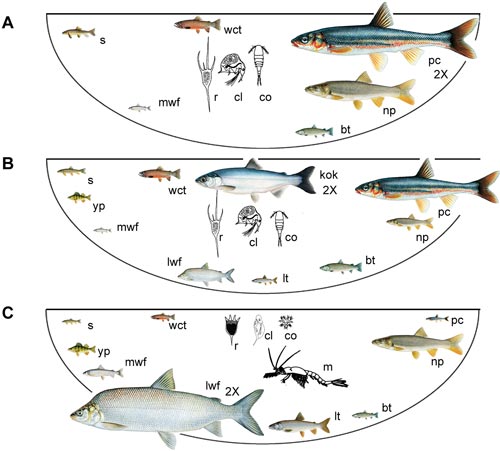[The Montana Professor 23.1, Fall 2012 <http://mtprof.msun.edu>]
Long-Term Effects of Nonnative Species Introductions to Flathead Lake, Montana
Bonnie Ellis, PhD
Research Assistant Professor of Limnology
University of Montana-Missoula
—Bonnie Ellis

Flathead Lake is a story of invasions. Second only to land transformation, biotic introductions or invasions are considered the most important cause of extinctions, often driving losses in biological diversity of native species. To increase the diversity of sport fishing, over 19 different nonnative fish species were introduced to Flathead Lake by fisheries managers beginning as early as 1890 and ending in the mid-1960s—although reintroduction of nonnative kokanee salmon continued into the late 1990s. From 1968 to 1976, a tiny crustacean known commonly as the opossum shrimp (Mysis diluviana) was introduced by Montana Fish, Wildlife and Parks into lakes upstream of Flathead Lake in an effort to bolster the popular nonnative kokanee fishery by providing an additional food source. It was the introduction of this small invertebrate that caused a rapid cascade of changes up and down the food chain. The complex interactions that led to these changes were the subject of a recent University of Montana study published in the Proceedings of the National Academy of Sciences.
Since the establishment of the UM's Flathead Lake Biological Station in 1899, scientists began studying the biological, chemical, and physical features (i.e., limnology) of the lake, including its fishery. An analysis of more than a century's worth of ecosystem data revealed four distinguishable periods in the lake food web. The first was the pre-1920 "native" period, when 10 native species dominated the fish community despite the introduction of 14 nonnative fish from 1890 to 1920. Cutthroat trout were predominant in angler catches at the time. The top predators (i.e., piscivores) were northern pikeminnow and bull trout.
In the 1920s, anglers began to report nonnative fishes and by 1940 nonnative kokanee expanded to a large population (i.e., 1.6–2.3 million), replacing cutthroat trout as the predominant catch. This "kokanee" period extended from about 1920 to 1984. Kokanee, a landlocked sockeye salmon species, began spawning very successfully in two groundwater upwelling zones on the lake shoreline. In later years, as the population grew, they established other spawning sites, notably the outlet of McDonald Lake in Glacier National Park. During 1980–1985, high kokanee spawner abundance drew congregations of bald eagles that fed on the spawning run at McDonald Creek; peak eagle densities exceeded 600 birds. Toward the end of this period, native cutthroat and non-native lake trout remained at low densities, while nonnative lake whitefish continued to expand.
The "mysid explosion" period from 1985 to 1988 was certainly the most dramatic era in the ever changing food web of Flathead Lake. The kokanee period ended abruptly in the mid-1980s with the establishment and rapid expansion of the glacial-relict opossum shrimp, Mysis diluviana. These cold-water crustaceans are about 1–2 centimeters long and get their name from the female's brood pouch where the embryos are carried for several weeks. Mysids migrate vertically through the water column, spending daytime hours on or near the lake bottom and coming up into the surface waters at night to feed on zooplankton—small animals suspended in the water column. Mysis was transferred from Waterton Lake, Alberta where it was native along with lake trout, to five lakes upstream of Flathead Lake from 1968 to 1976. The intention of fisheries managers was to promote kokanee populations by increasing forage, a program based on erroneous interpretations of the results of such introductions elsewhere. For example, mysids were introduced to Kootenay Lake to increase the size and numbers of rainbow trout, but the kokanee population proliferated instead. However, Kootenay was unique in that the contours of the lake bottom resulted in the current pattern of mysids being carried from deeper waters into a shallow bay where they become easy targets for salmon during the day. In other lakes, and most certainly in Flathead Lake, mysids could stay on the bottom of the lake away from the sight-feeding kokanee during the day and come up at night to feed. The mysid population in Flathead exploded, with lake wide densities averaging 125 individuals for every square meter of lake surface. The kokanee sport fishery collapsed the year after peak mysid abundance, and the eagles that had gathered annually at McDonald Creek to feed on the kokanee spawners dispersed to other regions as did the large fall gathering of Park visitors.
 The food web of Flathead Lake emphasizing three of the trophic levels (piscivores, planktivores, and herbivores) altered by the introduction of nonnative fishes and an opossum shrimp, Mysis deluviana. Dominant fish and zooplankton species are shown in the native community (A; 1915–1916), following more than a half century of nonnative fish introductions (B; 1981, 1983) and the present day community following the introduction of Mysis deluviana (C; 1996–2005). Organisms are not drawn to scale though size of fish roughly represents abundance during each period with "2X" denoting species about twice as abundant as shown. wct=westslope cutthroat trout, bt=bull trout, mwf=mountain whitefish, np=northern pikeminnow, pc=peamouth chub, s=longnose and largescale suckers, lt=lake trout, lwf=lake whitefish, kok=kokanee, yp=yellow perch, m=Mysis, r=rotifers, cl=cladocerans, co=copepods.Fish illustrations by Joe Tomelleri and zooplankton illustrations by Diane Whited
The food web of Flathead Lake emphasizing three of the trophic levels (piscivores, planktivores, and herbivores) altered by the introduction of nonnative fishes and an opossum shrimp, Mysis deluviana. Dominant fish and zooplankton species are shown in the native community (A; 1915–1916), following more than a half century of nonnative fish introductions (B; 1981, 1983) and the present day community following the introduction of Mysis deluviana (C; 1996–2005). Organisms are not drawn to scale though size of fish roughly represents abundance during each period with "2X" denoting species about twice as abundant as shown. wct=westslope cutthroat trout, bt=bull trout, mwf=mountain whitefish, np=northern pikeminnow, pc=peamouth chub, s=longnose and largescale suckers, lt=lake trout, lwf=lake whitefish, kok=kokanee, yp=yellow perch, m=Mysis, r=rotifers, cl=cladocerans, co=copepods.Fish illustrations by Joe Tomelleri and zooplankton illustrations by Diane Whited.
The fourth period of the lake's food web history, 1989 to present, is referred to as the "mysid-lake trout" period. The explosion of Mysis resulted in a ripple effect that altered the entire food web of Flathead Lake; the changes that occurred are best explained in terms of the theory of cascading trophic interactions. This concept explains how alterations in the profile of predators and/or prey in an ecosystem can cause changes in the abundance, biomass or productivity of a population, community, or nutritional (i.e., trophic) level across more than one link in the food web. Mysids prefer large, slow-moving prey; thus, particular zooplankton species were dramatically reduced, shifting not only the species composition but also the size structure of the community (i.e., more small zooplankton species after Mysis became established). The abundance and biomass of zooplankton declined by half during the Mysis expansion period. Since zooplankton feed on phytoplankton (suspended algae), changes cascaded through the phytoplankton community as well. Shifts in dominant phytoplankton species occurred, but the most important and unexpected finding was that the rate of primary productivity (production of organic compounds via photosynthesis) increased suddenly by 21%, exactly consistent with the peak in Mysis abundance, and has not decreased since then.
Both Mysis and kokanee prefer the same zooplankton for food; it was hypothesized early on that competition for the same prey caused the decline in kokanee (i.e., Mysis outcompeted kokanee for its primary food source). However, our recent bioenergetic research showed that the collapse of the kokanee population was best explained by the dramatic increase in the nonnative lake trout population and their subsequent predation on kokanee. Lake trout had been introduced 80 years earlier but remained at low densities because young lake trout had very limited food resources in the bottom waters they inhabited. Suddenly, an abundant new food source appeared on the lake bottom. Lake trout subsequently flourished on mysids and decimated the kokanee fishery. Lake trout 60 cm in length and greater consume primarily a fish diet, so many of the native fishes may now be at risk. Nonnative lake trout have now replaced native bull trout as the top predators in Flathead Lake. This is decidedly problematic for fisheries managers, given Endangered Species Act threatened status for bull trout. The research shows that recovery of bull and cutthroat trout will be difficult due to strong food web control by the expansive lake trout population.
The Flathead story documents complex trophic interactions: In this case, an introduced invertebrate planktivore displaced other piscine planktivores and facilitated ecological dominance by an introduced piscivore (which had been present for decades) that further depressed other piscine planktivores and piscine piscivores. This facilitation of the old invader (lake trout) by the recent invader (Mysis) eventually promoted a rapid shift in community structure resulting in a trophic cascade affecting phytoplankton, zooplankton, fish, and a nonaquatic species—the bald eagle. A top predator like lake trout may or may not be a strong interactor in a lake ecosystem depending upon the community and the species interactions found there. In Flathead Lake, lake trout were a top predator at low densities for many decades but were not a strong interactor until Mysis invaded and the community changed. It remains to be seen how much detailed quantitative knowledge of species-specific parameters would have been needed to predict this particular chain of events.
Over the years, much money and effort has been expended in attempts to reduce or control the lake trout population and give dwindling native fish such as bull trout and cutthroat trout room to survive. Understanding trophic cascades requires that long-term data sets be formalized by robust models able to account for the extreme complexity of interactions. One important challenge is to determine the tipping point for what might be the next ecosystem state as the community continues on its internally driven dynamics, and as external drivers such as climate change and direct human intervention (a lake-trout reduction program is under way, for example) further force the system.
[The Montana Professor 23.1, Fall 2012 <http://mtprof.msun.edu>]
Contents | Home

